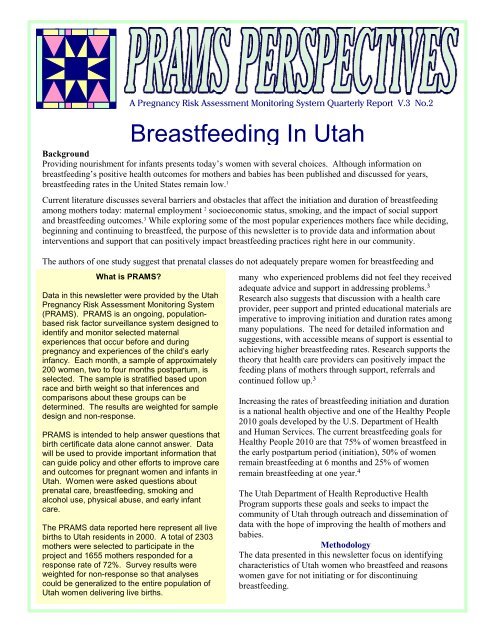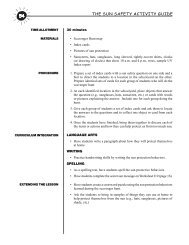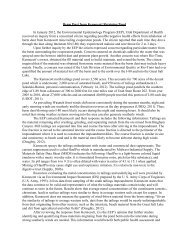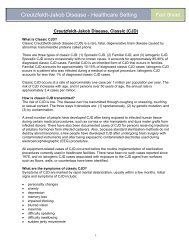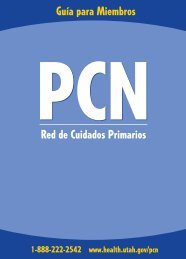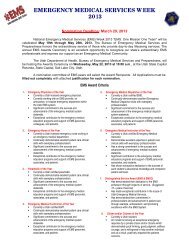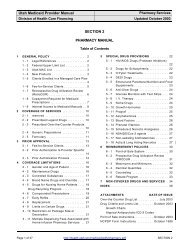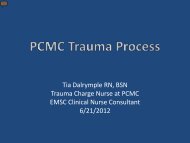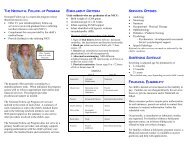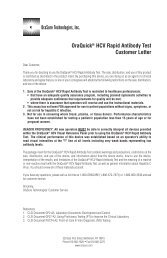Breastfeeding In Utah - Utah Department of Health - Utah.gov
Breastfeeding In Utah - Utah Department of Health - Utah.gov
Breastfeeding In Utah - Utah Department of Health - Utah.gov
You also want an ePaper? Increase the reach of your titles
YUMPU automatically turns print PDFs into web optimized ePapers that Google loves.
A Pregnancy Risk Assessment Monitoring System Quarterly Report V.3 No.2<br />
What is PRAMS?<br />
<strong>Breastfeeding</strong> <strong>In</strong> <strong>Utah</strong><br />
Background<br />
Providing nourishment for infants presents today’s women with several choices. Although information on<br />
breastfeeding’s positive health outcomes for mothers and babies has been published and discussed for years,<br />
breastfeeding rates in the United States remain low. 1<br />
Current literature discusses several barriers and obstacles that affect the initiation and duration <strong>of</strong> breastfeeding<br />
among mothers today: maternal employment 2 socioeconomic status, smoking, and the impact <strong>of</strong> social support<br />
and breastfeeding outcomes. 3 While exploring some <strong>of</strong> the most popular experiences mothers face while deciding,<br />
beginning and continuing to breastfeed, the purpose <strong>of</strong> this newsletter is to provide data and information about<br />
interventions and support that can positively impact breastfeeding practices right here in our community.<br />
The authors <strong>of</strong> one study suggest that prenatal classes do not adequately prepare women for breastfeeding and<br />
Data in this newsletter were provided by the <strong>Utah</strong><br />
Pregnancy Risk Assessment Monitoring System<br />
(PRAMS). PRAMS is an ongoing, populationbased<br />
risk factor surveillance system designed to<br />
identify and monitor selected maternal<br />
experiences that occur before and during<br />
pregnancy and experiences <strong>of</strong> the child’s early<br />
infancy. Each month, a sample <strong>of</strong> approximately<br />
200 women, two to four months postpartum, is<br />
selected. The sample is stratified based upon<br />
race and birth weight so that inferences and<br />
comparisons about these groups can be<br />
determined. The results are weighted for sample<br />
design and non-response.<br />
PRAMS is intended to help answer questions that<br />
birth certificate data alone cannot answer. Data<br />
will be used to provide important information that<br />
can guide policy and other efforts to improve care<br />
and outcomes for pregnant women and infants in<br />
<strong>Utah</strong>. Women were asked questions about<br />
prenatal care, breastfeeding, smoking and<br />
alcohol use, physical abuse, and early infant<br />
care.<br />
The PRAMS data reported here represent all live<br />
births to <strong>Utah</strong> residents in 2000. A total <strong>of</strong> 2303<br />
mothers were selected to participate in the<br />
project and 1655 mothers responded for a<br />
response rate <strong>of</strong> 72%. Survey results were<br />
weighted for non-response so that analyses<br />
could be generalized to the entire population <strong>of</strong><br />
<strong>Utah</strong> women delivering live births.<br />
many who experienced problems did not feel they received<br />
adequate advice and support in addressing problems. 3<br />
Research also suggests that discussion with a health care<br />
provider, peer support and printed educational materials are<br />
imperative to improving initiation and duration rates among<br />
many populations. The need for detailed information and<br />
suggestions, with accessible means <strong>of</strong> support is essential to<br />
achieving higher breastfeeding rates. Research supports the<br />
theory that health care providers can positively impact the<br />
feeding plans <strong>of</strong> mothers through support, referrals and<br />
continued follow up. 3<br />
<strong>In</strong>creasing the rates <strong>of</strong> breastfeeding initiation and duration<br />
is a national health objective and one <strong>of</strong> the <strong>Health</strong>y People<br />
2010 goals developed by the U.S. <strong>Department</strong> <strong>of</strong> <strong>Health</strong><br />
and Human Services. The current breastfeeding goals for<br />
<strong>Health</strong>y People 2010 are that 75% <strong>of</strong> women breastfeed in<br />
the early postpartum period (initiation), 50% <strong>of</strong> women<br />
remain breastfeeding at 6 months and 25% <strong>of</strong> women<br />
remain breastfeeding at one year. 4<br />
The <strong>Utah</strong> <strong>Department</strong> <strong>of</strong> <strong>Health</strong> Reproductive <strong>Health</strong><br />
Program supports these goals and seeks to impact the<br />
community <strong>of</strong> <strong>Utah</strong> through outreach and dissemination <strong>of</strong><br />
data with the hope <strong>of</strong> improving the health <strong>of</strong> mothers and<br />
babies.<br />
Methodology<br />
The data presented in this newsletter focus on identifying<br />
characteristics <strong>of</strong> <strong>Utah</strong> women who breastfeed and reasons<br />
women gave for not initiating or for discontinuing<br />
breastfeeding.
<strong>Utah</strong> PRAMS and birth certificate data from 2000 were used to determine the prevalence <strong>of</strong> breastfeeding and the<br />
reasons for non-initiation and discontinuation. PRAMS respondents were asked the following questions regarding<br />
their experience with breastfeeding during their most recent pregnancy (note: questions 48 and 51 respondents<br />
were asked to check all that apply).<br />
<strong>In</strong>itiation Questions:<br />
47. Did you ever breastfeed or pump breast milk to feed your new baby after delivery?<br />
48. What were your reasons for not breastfeeding your new baby? (Check all that apply)<br />
o I had other children to take care <strong>of</strong><br />
o I had too many household duties<br />
o I did not like breastfeeding<br />
o I did not want to be tied down<br />
o I was embarrassed to breastfeed<br />
o I went back to work or school<br />
o My husband or partner did not want me to breastfeed<br />
o I wanted my body back to myself<br />
o Other – Please tell us:<br />
Duration Questions:<br />
49. Are you still breastfeeding or feeding pumped milk to your new baby?<br />
51. What are your reasons for stopping breastfeeding? (Check all that apply)<br />
o My baby had difficulty nursing<br />
o Breast milk alone did not satisfy my baby<br />
o I thought my baby was not gaining enough weight<br />
o My baby became sick and could not breastfeed<br />
o My nipples were sore, cracked, or bleeding<br />
o I thought I was not producing enough milk<br />
o I had too many other household duties<br />
o I felt it was the right time to stop breastfeeding<br />
o I became sick and could not breastfeed<br />
o I went back to work or school<br />
o My husband or partner wanted me to stop breastfeeding<br />
o I wanted or needed someone else to feed the baby<br />
o Other – Please tell us:<br />
Chi-square testing was used to identify significant barriers to initiation and duration <strong>of</strong> breastfeeding. It is<br />
important to note that because the PRAMS survey is completed postpartum, there may be some recall bias from<br />
mothers when answering these questions. It should also be noted that the average time in which a mother<br />
completes the survey is between 2-4 months postpartum, thus timing <strong>of</strong> the receipt <strong>of</strong> the survey could affect<br />
duration rates reported.<br />
Prevalence <strong>of</strong> <strong>Breastfeeding</strong> <strong>In</strong> <strong>Utah</strong><br />
<strong>In</strong>itiation<br />
<strong>Utah</strong> meets and exceeds the <strong>Health</strong>y People 2010 Goal for initiation rates with 87.7% <strong>of</strong> <strong>Utah</strong> PRAMS<br />
respondents reporting having breastfeed at one time.<br />
Of the 87.7% women who reported initiating breastfeeding, 76.3% reported their prenatal care provider spoke with<br />
them about breastfeeding. Women who discussed breastfeeding with their health care provider were significantly<br />
more likely to initiate breastfeeding than those who did not. As research emphasizes increased confidence <strong>of</strong> a<br />
mother through <strong>of</strong>fice visit discussions impacts her decision to breastfeed. 5<br />
-2-
Table 1 shows the percentage <strong>of</strong> women with live births who reported ever breastfeeding or still breastfeeding by<br />
selected maternal characteristics. Each subgroup listed in Table 1 had significantly different proportions, except<br />
where noted.<br />
Table 1. Percentage <strong>of</strong> Women with Live Births who Reported Ever <strong>Breastfeeding</strong> or Still<br />
<strong>Breastfeeding</strong> by Selected Maternal Characteristics<br />
Percentage <strong>of</strong><br />
Women Who<br />
Percentage <strong>of</strong><br />
Women<br />
<strong>Breastfeeding</strong><br />
When Survey<br />
Characteristics<br />
Total Birth Population 87.7 + 2.2 65.9 + 3.3<br />
Maternal Age NS*<br />
< 17 80.1 + 22.4 3.4 + 4.0<br />
18 - 19 78.5 + 12.8 31.8 + 15.0<br />
20 - 24 87.3 + 4.0 63.1 + 6.1<br />
25 - 29 88.7 + 3.5 70.8 + 5.4<br />
30 - 34 90.5 + 4.4 73.7 + 7.1<br />
35 - 39 87.5 + 9.2 78.7 + 9.8<br />
40 +<br />
Education Level<br />
87.4 + 15.6 51.1 + 21.9<br />
Less than High School 70.6 + 9.4 33.2 + 11.1<br />
Completed High School 81.7 + 4.7 57.1 + 6.5<br />
Some College 93.4 + 2.8 69.9 + 5.6<br />
College Graduate<br />
Race<br />
97.2 + 2.3 83.6 + 4.7<br />
White 87.9 + 2.3 66.8 + 3.5<br />
Other than White<br />
Marital Status<br />
82.7 + 3.4 51.9 + 4.7<br />
Married 89.5 + 2.2 71.4 + 3.3<br />
Unmarried 78.8 + 7.2 34.5 + 9.5<br />
Ethnicity NS<br />
Hispanic 80.4 + 8.0 45.4 + 11.1<br />
Non-Hispanic<br />
<strong>In</strong>tendedness <strong>of</strong> Pregnancy<br />
88.7 + 2.3 68.8 + 3.4<br />
<strong>In</strong>tended 89.6 + 2.4 71.5 + 3.8<br />
Unintended<br />
Annual Household <strong>In</strong>come<br />
83.8 + 4.7 55.2 + 6.5<br />
< $15,000 83.9 + 5.4 49.2 + 8.1<br />
$15,000 - 35,000 88.4 + 3.6 67.8 + 5.7<br />
$35,000 - 50,000 87.3 + 5.6 72.1 + 7.2<br />
> $50,000<br />
<strong>Health</strong> <strong>In</strong>surance Coverage Before Conception<br />
92.6 + 3.4 74.9 + 5.8<br />
2<br />
Ever Breastfed<br />
Yes 89.4 + 2.4 69.7 + 3.7<br />
No 82.9 + 5.1 53.7 + 7.3<br />
Medicaid Coverage Before Conception NS<br />
Yes 76.3 + 13.7 41.1 + 18.8<br />
No<br />
Enrolled in WIC During Pregnancy?<br />
88.1 + 2.2 66.6 + 3.4<br />
Yes 82.7 + 5.0 52.2 + 7.0<br />
No<br />
Prenatal Care (PNC) Payer<br />
89.8 + 2.3 71.4 + 3.6<br />
Private/Group <strong>In</strong>surance 89.8 + 2.5 69.8 + 3.8<br />
Medicaid 80.5 + 5.7 56.8 + 7.5<br />
Other/Self Pay 92.0 + 5.2 60.3 + 12.3<br />
1<br />
Completed 1<br />
-3-
Table 1. Ppercentage <strong>of</strong> Women with Live Births who Reported Ever <strong>Breastfeeding</strong> or Still<br />
<strong>Breastfeeding</strong> by Selected Maternal Characteristics, continued<br />
Characteristics<br />
Total Birth Population<br />
Delivery Payer<br />
87.7 + 2.2 65.9 + 3.3<br />
Private/Group <strong>In</strong>surance 90.3 + 2.5 70.1 + 3.8<br />
Medicaid 82.4 + 4.9 54.6 + 7.1<br />
Other/Self Pay<br />
Partner Associated Stress<br />
82.2 + 10.9 67.6 + 14.7<br />
3<br />
Yes 82.8 + 4.8 54.8 + 6.9<br />
No<br />
Traumatic Stress<br />
89.7 + 2.4 70.0 + 3.7<br />
4<br />
Yes 77.1 + 7.3 46.4 + 10.1<br />
No 89.7 + 2.2 69.1 + 3.4<br />
Financial Stress 5<br />
Percentage <strong>of</strong><br />
Women Who<br />
Ever Breastfed<br />
NS<br />
Yes 88.4 + 2.8 62.6 + 4.5<br />
No 86.9 + 3.5 70.1 + 4.9<br />
Postpartum Depression NS<br />
Not Depressed 88.9 + 3.8 70.1 + 5.8<br />
Slightly Depressed 88.8 + 3.3 67.8 + 4.9<br />
Moderately Depressed 84.3 + 5.9 59.0 + 8.6<br />
Very Depressed 81.8 + 11.9 55.3 + 18.0<br />
Very Depressed - Needed Help<br />
Previous Live Births<br />
86.4 + 15.2 42.1 + 23.1<br />
None 90.8 + 3.5 58.6 + 5.9<br />
1 - 4 85.6 + 3.0 69.6 + 4.2<br />
5 or more<br />
Drank 3 months before pregnancy<br />
93.0 + 7.5 78.1 + 14.7<br />
Yes 79.9 + 6.0 48.7 + 7.9<br />
No<br />
Smoked 3 months before pregnancy<br />
90.0 + 2.3 70.9 + 3.6<br />
Yes 71.2 + 8.7 32.8 + 10.0<br />
No<br />
Smoked last 3 months <strong>of</strong> pregnancy<br />
90.9 + 2.0 70.6 + 3.4<br />
Yes 70.3 + 12.2 26.3 + 13.2<br />
No<br />
Smoking Now<br />
89.4 + 2.2 68.8 + 3.4<br />
Yes 65.7 + 11.0 19.2 + 9.7<br />
No 90.2 + 2.1 69.9 + 3.3<br />
1<br />
Percentage <strong>of</strong><br />
Women<br />
<strong>Breastfeeding</strong><br />
When Survey<br />
Completed 1<br />
1 Plus or minus 95% confidence interval<br />
2 Women were asked not to include Medicaid when answering this question<br />
3 Separation or divorce, arguing with partner, or partner not wanting pregnancy<br />
4 Jail, physical fight, being homeless, close person with drug or alcohol use<br />
5<br />
Loss <strong>of</strong> job for woman or partner, unpaid bills, move to a new address<br />
* Not statistically significant<br />
The populations listed below reported statistically significant differences in breastfeeding initiation with rates that<br />
differed from the general population by more than 10% (Table 1):<br />
· Less than high school education<br />
· Experienced traumatic stress during the pregnancy<br />
· Smoked in the three months before pregnancy<br />
· Smoked in the last three months <strong>of</strong> pregnancy<br />
· Smoke now<br />
-4-
Smoking has been identified in recent a meta-analysis as increasing the risk <strong>of</strong> early weaning. This analysis<br />
suggested that “The effect <strong>of</strong> smoking on breastfeeding duration may be confounded by self-selection in that<br />
smoking mothers may be less health conscious and consequently, less likely to breastfeed.” 6<br />
Figure 1 illustrates the percentage <strong>of</strong> women who reported reasons for never initiating breastfeeding.<br />
The choice “ I did not like breastfeeding” ranked 2 nd highest at 37.3%, with the choice “Other” leading at 38%.<br />
The choice “My husband or partner did not want me to breastfeed” ranked lowest at 2%. “Other” included a wide<br />
variety <strong>of</strong> reasons mothers listed indicating that this issue is very unique and specific to the individual.<br />
Figure 1. Reasons <strong>In</strong>dicated by PRAMS Respondents for Never <strong>In</strong>itiating <strong>Breastfeeding</strong>,<br />
2000 <strong>Utah</strong> PRAMS Data<br />
My husband or partner did not want me<br />
to breastfeed<br />
I was embarassed to breastfeed<br />
I did not want to be tied down<br />
I had too many household duties<br />
I wanted my body back to myself<br />
I went back to work or school<br />
I had other children to take care <strong>of</strong><br />
I did not like breastfeeding<br />
Other<br />
0.0% 5.0% 10.0% 15.0% 20.0% 25.0% 30.0% 35.0% 40.0% 45.0% 50.0%<br />
Duration<br />
The <strong>Health</strong>y People 2010 goals for duration are 50% at six months and 25% at one year. Of the 2000 <strong>Utah</strong><br />
PRAMS respondents 65.9% reported still breastfeeding at the time they completed the survey, which is<br />
approximately 4 months postpartum. Of the women who completed the survey when their infant was 6 months or<br />
older (approximately 7% <strong>of</strong> respondents), 47.4% reported they were still breastfeeding.<br />
Publishing information<br />
This publication was supported by Grant Number U50/CCU817126-03 from the Centers for Disease<br />
Control and Prevention (CDC). Its contents are solely the responsibility <strong>of</strong> the authors and do not<br />
necessarily represent the <strong>of</strong>ficial views <strong>of</strong> CDC.<br />
Authors:<br />
Ayanna Harrison, BS, PRAMS Operations Manager<br />
Laurie Baksh, MPH, PRAMS Data Manager<br />
Lois Bloebaum, BSN, Manager, Reproductive <strong>Health</strong> Program<br />
Christy Van Orman, RN, BSN, IBCLC, formerly <strong>Utah</strong> <strong>Department</strong> <strong>of</strong> <strong>Health</strong>, Nurse Case Manager<br />
Judy Harris, RD, CD, IBCLC, <strong>Utah</strong> <strong>Department</strong> <strong>of</strong> <strong>Health</strong>, WIC<br />
Holly Hostetter, RD, CD, CLE, Private Lactation Educator and Consultant<br />
-5-
Table 1 illustrates the characteristics <strong>of</strong> women that are statistically significant related to discontinuation <strong>of</strong><br />
breastfeeding:<br />
· Younger Age (< 17, and 18-19)<br />
· Less than high school education<br />
· Other than white race<br />
· Hispanic ethnicity<br />
· Unmarried<br />
· Unintended pregnancy<br />
· Medicaid coverage before conception<br />
· WIC enrollment during pregnancy<br />
· Postpartum depression<br />
· Smoking (last three months <strong>of</strong> pregnancy and presently smoking)<br />
· Reported partner associated or traumatic stress during the pregnancy.<br />
Figure 2 illustrates the reasons PRAMS respondents indicated for not continuing to breastfeed. It should be noted<br />
that, “I thought I was not producing enough milk” was the number one reason many women stated they did not<br />
continue to breastfeed their babies, with 36.3% <strong>of</strong> PRAMS respondents choosing this reason as an option. Current<br />
studies communicate a similar message. <strong>In</strong> the article, “Factors <strong>In</strong>fluencing Continuation <strong>of</strong> <strong>Breastfeeding</strong> in a<br />
Cohort <strong>of</strong> Women”, the findings state that low milk supply was in the top five reasons women listed for why they<br />
stopped breastfeeding. 3 Women are also returning to work sooner, making establishing an adequate milk supply a<br />
leading concern. Mothers who use breast pumps or hand express are more likely to nurse longer than women who<br />
don’t. 2 However knowing how to effectively manage and maintain the breastfeeding relationship once a woman<br />
returns to work has become a challenging obstacle.<br />
Figure 2. Reasons chosen by PRAMS respondents for discontinuing <strong>Breastfeeding</strong>,<br />
2000 <strong>Utah</strong> PRAMS Data<br />
My husband or partner wanted me to<br />
stop breastfeeding<br />
My baby became sick and could not<br />
breastfeed<br />
I became sick and could not<br />
breastfeed<br />
I had too many other household<br />
duties<br />
I thought my baby was not gaining<br />
enough weight<br />
I felt it was the right time to stop<br />
breastfeeding<br />
I wanted or needed someone else to<br />
feed the baby<br />
My nipples were sore, cracked, or<br />
bleeding<br />
Other<br />
My baby had difficulty nursing<br />
I went back to work or school<br />
Breast milk alone did not satisfy my<br />
baby<br />
I thought I was not producing enough<br />
milk<br />
0.0% 5.0% 10.0% 15.0% 20.0% 25.0% 30.0% 35.0% 40.0% 45.0%<br />
-6-
Summary/Recommendations<br />
The World <strong>Health</strong> Organization states that “breastfeeding is an unequalled way <strong>of</strong> providing ideal food for the<br />
healthy growth and development <strong>of</strong> infants; it is also an integral part <strong>of</strong> the reproductive process with important<br />
implications for the health <strong>of</strong> mothers. As a global public health recommendation, infants should be exclusively<br />
breastfed for the first six months <strong>of</strong> life to achieve optimal growth, development and health. Thereafter, to meet<br />
their evolving nutritional requirements, infants should receive nutritionally adequate and safe complementary<br />
foods while breastfeeding continues for up to two years <strong>of</strong> age or beyond. Exclusive breastfeeding from birth is<br />
possible except for a few medical conditions, and unrestricted exclusive breastfeeding results in ample milk<br />
production”. 7<br />
Current literature suggests that “prenatal classes do not adequately prepare women for breastfeeding” 3 and many<br />
who experienced problems did not feel they received adequate advice and support in addressing problems.<br />
However this study went on to suggest that the potential to improve rates <strong>of</strong> breastfeeding is there by assisting<br />
mother in “creating realistic expectations about breastfeeding, and ensuring access to consistent information and<br />
ongoing support from partners, family, friends, pr<strong>of</strong>essionals, and the community.” 3<br />
Mother’s perceptions have been cited as a large barrier to initiation and duration <strong>of</strong> breastfeeding, thus adequate<br />
support beyond prenatal courses is necessary to combat this issue. When health care providers <strong>of</strong>fer<br />
encouragement and support, breastfeeding rates may be increased and duration rates extended.<br />
<strong>Health</strong> care providers must be prepared to support women with updated information and referrals when necessary.<br />
<strong>Breastfeeding</strong> is natural, but it is a learned behavior. Theoretically most women are capable <strong>of</strong> breastfeeding their<br />
baby providing they have accurate and accessible information. 7<br />
Support from family, community and the health care system is essential. The World <strong>Health</strong> Organization reports<br />
that the health care system can provide support through (partial list); skilled counseling, supportive hospital<br />
practices, increasing antenatal care and education about breastfeeding, and promoting good nutrition for pregnant<br />
and lactating women. 7<br />
The American Academy <strong>of</strong> Pediatrics (AAP) states, “<strong>Breastfeeding</strong> ensures the best possible health as well as the<br />
best developmental and psychosocial outcomes <strong>of</strong> the infant. Enthusiastic support and involvement <strong>of</strong> pediatricians<br />
in the promotion and practice <strong>of</strong> breastfeeding is essential to the achievement <strong>of</strong> optimal infant and child health,<br />
growth, and development.” 8<br />
Although breastfeeding is generally considered an obstetric issue, pediatric providers are very aware <strong>of</strong> how the<br />
benefits <strong>of</strong> breast milk directly affect the population they serve. Since pediatricians are in contact with mothers<br />
during routine well-baby checkups, these visits provide the opportune times to consult about any breastfeeding<br />
issues that may arise, providing referrals and resources if necessary.<br />
Pediatricians can provide an optimal environment for breastfeeding in the following ways (partial list) 8 :<br />
• Considering <strong>of</strong> published evidence for improved outcomes in breastfed infants<br />
• Becoming knowledgeable and skilled in the physiology and clinical management <strong>of</strong> breastfeeding<br />
• Working with the obstetric community to ensure women receive adequate information throughout the perinatal<br />
period<br />
• Promoting hospital policies and procedures that facilitate breastfeeding<br />
• Becoming familiar with breastfeeding resources<br />
• Promoting breastfeeding as a normal part <strong>of</strong> daily life<br />
• Promoting breastfeeding education as a routine component <strong>of</strong> provider education<br />
Enclosed you will find a printer friendly <strong>Utah</strong> PRAMS <strong>Breastfeeding</strong> Resource Guide*. This guide was produced<br />
and researched by the authors <strong>of</strong> this newsletter. <strong>In</strong>ternet links, breastfeeding services/rentals, and reading<br />
materials will all provide a great introduction to the world <strong>of</strong> breastfeeding. For more information on breastfeeding<br />
and other maternal child health issues please visit our website www.health.utah.<strong>gov</strong>/rhp . *<strong>In</strong>clusion <strong>of</strong> resources<br />
does not imply endorsement by The <strong>Utah</strong> <strong>Department</strong> <strong>of</strong> <strong>Health</strong>.<br />
-7-
References:<br />
1. Chezem, J., Friesen, C., and Boettcher, J.: <strong>Breastfeeding</strong> knowledge, breastfeeding confidence, and infant<br />
feeding plans: effects on actual feeding practices. J Obstet Gynecol Neonatal Nurs 32: 40-7. (2003).<br />
2. Auerbach, K. G., and Guss, E.: Maternal employment and breastfeeding. A study <strong>of</strong> 567 women’s<br />
experiences. Am J Dis Child 138: 958-60. (1984).<br />
3. McLeod, D., Pullon, S., and Cookson, T.: Factors influencing continuation <strong>of</strong> breastfeeding in a cohort <strong>of</strong><br />
women. J Hum Lact 18: 335-43. (2002).<br />
4. U. S. <strong>Department</strong> <strong>of</strong> <strong>Health</strong> and Human Services: <strong>Health</strong>y People 2010. 2nd ed. With Understanding and<br />
Improving <strong>Health</strong> and Objectives for Improving <strong>Health</strong>. 2 vols, Washington, DC, 2000.<br />
5. Blyth, R., et al.: Effect <strong>of</strong> maternal confidence on breastfeeding duration: an application <strong>of</strong> breastfeeding<br />
self-efficacy theory. Birth 29: 278-84. (2002).<br />
6. Horta, B. L., Kramer, M. S., and Platt, R. W.: Maternal smoking and the risk <strong>of</strong> early weaning: a metaanalysis.<br />
Am J Public <strong>Health</strong> 91: 304-7. (2001).<br />
7. <strong>In</strong>fant and young child nutrition:Global strategy on infant and young child feeding. World <strong>Health</strong><br />
Organization, 2002, pp. 1-18.<br />
8. <strong>Breastfeeding</strong> and the use <strong>of</strong> human milk. American Academy <strong>of</strong> Pediatrics, Work Group on<br />
<strong>Breastfeeding</strong>. Pediatrics 100: 1035-39 (1997).<br />
Reproductive <strong>Health</strong> Program<br />
<strong>Utah</strong> <strong>Department</strong> <strong>of</strong> <strong>Health</strong><br />
P.O. Box 142001<br />
Salt Lake City, <strong>Utah</strong> 84114-2001<br />
RETURN SERVICE<br />
REQUESTED


